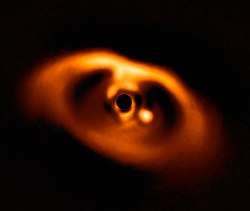Super-Neptune
A super-Neptune is a planet that is more massive than the planet Neptune. These planets are generally described as being around 5–7 times as large as Earth with estimated masses of 20–80 M⊕;[1] beyond this they are generally referred to as gas giants.
There have been relatively few discoveries of this kind of planets. Known examples include Kepler-101b, HAT-P-11b, and K2-33b.[2][3]
See also
References
- http://www.space.com/6338-super-neptune-planet.html
- Bonomo, A. S.; Sozzetti, A.; Lovis, C.; Malavolta, L.; Rice, K.; Buchhave, L. A.; Sasselov, D.; Cameron, A. C.; Latham, D. W.; Molinari, E.; Pepe, F.; Udry, S.; Affer, L.; Charbonneau, D.; Cosentino, R.; Dressing, C. D.; Dumusque, X.; Figueira, P.; Fiorenzano, A. F. M.; Gettel, S.; Harutyunyan, A.; Haywood, R. D.; Horne, K.; Lopez-Morales, M.; Mayor, M.; Micela, G.; Motalebi, F.; Nascimbeni, V.; Phillips, D. F.; Piotto, G.; et al. (2014). "Characterization of the planetary system Kepler-101 with HARPS-N". Astronomy & Astrophysics. 572: A2. arXiv:1409.4592. Bibcode:2014A&A...572A...2B. doi:10.1051/0004-6361/201424617.
- http://phys.org/news/2016-06-young-super-neptune-clues-close-in-exoplanet.html
This article is issued from Wikipedia. The text is licensed under Creative Commons - Attribution - Sharealike. Additional terms may apply for the media files.
